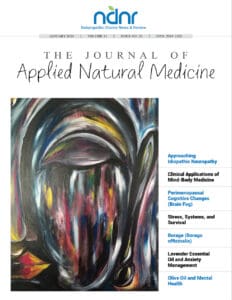Decker Weiss, NMD, FASA
Docere
How Did Sneezy and Grumpy End Up in Cardiac ICU?
There is a link between histamine production, depression, heart disease, and myocardial infarction. It is reasonable to assume that histamine production and release due to destabilization of mast cells and basophils is increased in patients with seasonal allergies.1 Recently, the American Heart Association approved the symptom and/or diagnosis of depression as a risk factor for both heart disease and myocardial infarction.2 Might there also be a link between histamine and cardiovascular risk? Might the “blue mood” that patients are telling us about during allergy season be putting them at immediate risk of a heart attack? First, let’s look at the physiologic effect of histamine on the heart.
A New Look at Histamine
Histamine has long been known to be a key component in the body’s response to allergies. However, histamine also functions as a stimulatory neurotransmitter – in digestion as well as sleep.3 Histamine has an overall stimulatory effect on the brain and body,4 while having an odd effect on the vascular system. Histamine exerts a negative inotropic (squeeze) force on the heart.5 However, under certain circumstances, cardiac mast cells release not only histamine, but also chymase and renin that activate the angiotensin system locally, which in turn induces arteriolar vasoconstriction.5 So, while histamine can be generally vasodilatory, cardiac mast cells can release both vasoconstricting and vasodilatory substances, depending on need.5 The number and density of cardiac mast cells is increased in patients with ischemic heart disease and dilated cardiomyopathy; the direct effect of histamine on the heart increases as well.5 In theory, the chronic allergy patient will have a higher presence of mast cell activity and inflammation in his or her heart tissue than the non-allergy patient.
Histamine & Depression
In an animal model, histamine was shown to suppress the production of serotonin in the dorsal raphe nucleus of the brain.6 Serotonin production in the dorsal raphe is responsible, in part, for the hypothalamic/pituitary/adrenal (HPA) axis response to stress.7 So, the release of cortisol is also affected as histamine is released, providing a potential additional issue that can lead to depression and other problems.8
Does this mean that there is a link between seasonal affective disorder (SAD) and histamine? Yes. SAD is a form of recurrent depressive or bipolar disorder. The condition was first believed to be related to abnormal melatonin metabolism, but later findings did not support this hypothesis. Studies now link SAD to disturbed serotonin production.9 Serotonin insufficiency as a mechanism of depression is accepted; it is also a mechanism for seasonal affective disorder.10 So, the links are there: allergy season to histamine, histamine to serotonin and cortisol, and serotonin to depression. But what about a link between histamine and heart disease and heart attacks?
The Histamine-Serotonin-Endothelial Connection
Selective serotonin reuptake inhibitor (SSRI) antidepressants, such as fluoxetine, paroxetine, sertraline, and citalopram, are being used to reduced cardiovascular morbidity and mortality by increasing available serotonin.11 The mechanism appears to be via nitric oxide (NO), as serotonin stimulates increased activity of endothelial NO synthase (eNOS). This results in a larger release of nitric oxide, causing relaxation of the underlying vascular smooth muscle.12 The concentration of neurotransmitters such as serotonin is also increased by estrogen, creating an interdependence of estrogen and serotonin to support healthy endothelium.13 Endothelial dysfunction is one of the accepted mechanisms in the development of both heart disease and heart attacks.14
Putting It All Together
Two 50-year-old males with a family history of cardiovascular disease come into your office complaining of sneezing and sadness, and are aptly named Sneezy and Grumpy. In looking at cardiac risk in a different way, and in an effort to try to better diagnose their August (ragweed) blue mood and sneezes, you run a urine neurotransmitter panel and find low serotonin and elevated histamine.
With these findings, and being a well-read practitioner, you understand that these imbalances can have various cardiovascular effects including endothelial dysfunction. In addition to antioxidants and endothelial support, 5-HTP and mast cell-stabilizing vitamin C and quercetin are prescribed to support the mission of heart attack and atherosclerosis prevention. Later, these patients are happy because their mood and sneezing improved, and the practitioner is happy because improving the patients’ mood and sneezing may have also prevented a heart attack. Later on, it was reported that Grumpy and Sneezy changed their names to Ecstatica and Nosneezia… a much better fit.
References:
- White MV. The role of histamine in allergic diseases. J Allergy Clin Immunol. 1990;86(4 Pt 2):599-605.
- Lichtman JH, Bigger JT Jr, Blumenthal JA, et al. AHA science advisory. Depression and coronary heart disease. Recommendations for screening, referral, and treatment. A science advisory from the American Heart Association Prevention Committee of the Council on Cardiovascular Nursing, Council on Clinical Cardiology, Council on Epidemiology and Prevention, and Interdisciplinary Council on Quality of Care and Outcomes Research. Endorsed by the American Psychiatric Association. Prog Cardiovasc Nurs. 2009;24(1):19-26.
- Regenerative Medicine: The Future of Health. Introduction to the Immune System. Duquesne University RegMed Web site. http://sepa.duq.edu/regmed/immune/histamine.html. Accessed October 1, 2015.
- McCormick DA. Neurotransmitter actions in the thalamus and cerebral cortex. J Clin Neurophysiol. 1992;9(2):212-223.
- Triggiani M, Patella V, Staiano RI, et al. Allergy and the cardiovascular system. Clin Exp Immunol. 2008;153 Suppl 1:7-11.
- Lakoski JM, Gallager DW, Aghajanian GK. Histamine-induced depression of serotoninergic dorsal raphe neurons: antagonism by cimetidine, a reevaluation. Eur J Pharmacol. 1984;103(1-2):153-156.
- Leonard BE. The HPA and immune axes in stress: the involvement of the serotonergic system. Eur Psychiatry. 2005;20 Suppl 3:S302–S306.
- Cowen PJ. Cortisol, serotonin and depression: all stressed out? Br J Psychiatry. 2002;180:99-100.
- Partonen T, Lönnqvist J. Seasonal affective disorder. Lancet. 1998;352(9137):1369-1374.
- Rosenthal NE, Mazzanti CM, Barnett RL, et al. Role of serotonin transporter promoter repeat length polymorphism (5-HTTLPR) in seasonality and seasonal affective disorder. Mol Psychiatry. 1998;3(2):175-177.
- Wozniak G, Toska A, Saridi M, Mouzas O. Med Sci Monit. 2011 Sep;17(9):RA205-14.Serotonin reuptake inhibitor antidepressants (SSRIs) against atherosclerosis. Med Sci Monit. 2011;17(9):RA205-RA214.
- Vanhoutte PM, Shimokawa H, Tang EH. Feletou M. Endothelial dysfunction and vascular disease. Acta Physiol. 2009;196(2):193-222.
- Archer JS. Estrogen and Mood Change via CNS Activity. Menopausal Medicine. 1999;7(4):4-8. Available at: http://tinyurl.com/pvq2v42. Accessed October 1, 2015.
- Hadi HA, Carr CS, Al Suwaidi J. Endothelial dysfunction: cardiovascular risk factors, therapy, and outcome. Vasc Health Risk Manag. 2005;1(3):183-198.
 Decker Weiss, NMD, FASA, became the first naturopathic cardiologist, completing a hospital-based training in the Columbia Hospital system, the Arizona Heart Institute, and the Arizona Heart Hospital. He went on to become a Fellow of the American Society of Angiology. Dr. Weiss kept privileges at the Arizona Heart Hospital for over a decade while also founding the Scottsdale Heart Institute, where he helped thousands of cardiovascular patients. In 2012, the International Association of Health Care Practitioners and the International Association of Cardiologists named Dr. Weiss a “Leading Physician in the World.” Dr. Weiss sits on the Functional Genomics and Translational Biology Committee for the American Heart Association. He maintains a teaching-based practice, while shifting the rest of his efforts to intractable conflict resolution as a Senior Fellow and Director for Artis Research’s Center for Health and Medicine.
Decker Weiss, NMD, FASA, became the first naturopathic cardiologist, completing a hospital-based training in the Columbia Hospital system, the Arizona Heart Institute, and the Arizona Heart Hospital. He went on to become a Fellow of the American Society of Angiology. Dr. Weiss kept privileges at the Arizona Heart Hospital for over a decade while also founding the Scottsdale Heart Institute, where he helped thousands of cardiovascular patients. In 2012, the International Association of Health Care Practitioners and the International Association of Cardiologists named Dr. Weiss a “Leading Physician in the World.” Dr. Weiss sits on the Functional Genomics and Translational Biology Committee for the American Heart Association. He maintains a teaching-based practice, while shifting the rest of his efforts to intractable conflict resolution as a Senior Fellow and Director for Artis Research’s Center for Health and Medicine.

